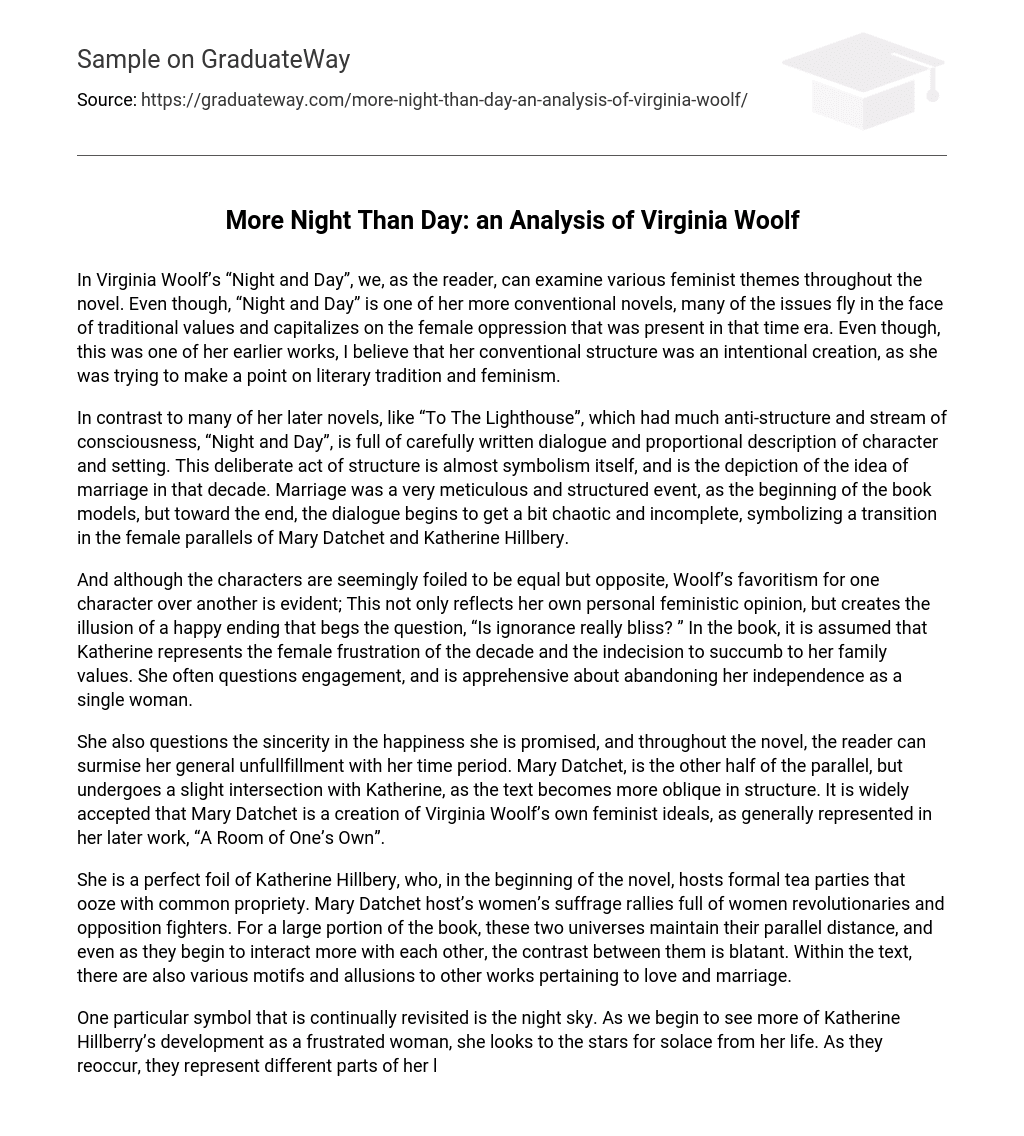The novel “Night and Day” by Virginia Woolf explores various feminist themes. Despite being a more conventional work, it challenges traditional values and highlights the oppression faced by women during that time period. Although it is one of her earlier works, the deliberate use of a conventional structure in “Night and Day” serves to make a statement on literary tradition and feminism.
“Night and Day” is different from later novels like “To The Lighthouse” in terms of its structure and writing style. While “To The Lighthouse” exhibits anti-structure and stream of consciousness, “Night and Day” offers carefully written dialogue and proportional description of character and setting. This deliberate use of structure serves as a symbol for the idea of marriage during that time period. In the beginning of the book, the depiction of marriage is meticulous and structured, but as the story progresses, the dialogue becomes chaotic and incomplete, representing the transition experienced by female characters Mary Datchet and Katherine Hillbery.
Although the characters may appear to be equal yet opposite, Woolf’s preference for one character over another is clearly visible. This not only mirrors her own feminist viewpoint but also gives the illusion of a happy ending that raises the question, “Is ignorance truly bliss?” In the novel, it is implied that Katherine embodies the frustrations faced by women during that period and the dilemma of conforming to societal expectations. She frequently contemplates marriage and is hesitant to give up her independence as a single woman.
The protagonist expresses doubt about the authenticity of the happiness she is guaranteed and consistently shows dissatisfaction with her era throughout the novel. Mary Datchet, on the other hand, shares similarities with Katherine but veers into a different narrative structure. It is widely acknowledged that Mary Datchet embodies Virginia Woolf’s feminist beliefs, as evident in her later work “A Room of One’s Own”.
She is a perfect contrast to Katherine Hillbery, who, at the start of the novel, holds formal tea parties that exude conventional etiquette. Mary Datchet organizes women’s suffrage rallies filled with revolutionary women and opponents. For a significant part of the book, these two worlds maintain their separate paths, and even as they start to engage with each other more frequently, the difference between them is evident. Additionally, the text includes different themes and references to other literary works concerning love and marriage.
The night sky is a recurring symbol in Katherine Hillberry’s life, serving as a source of comfort and escape for her. It represents her frustration and longing for fulfillment as a woman. The stars, in particular, symbolize different aspects of her life and the unattainable possibilities that she yearns for. Henry acknowledges this when he tells her that she lives her life by the stars, as she often finds herself navigating through both earthly and celestial realms, much like the night sky itself.
Despite being expected to pursue literature, she instead gravitates towards the fields of astronomy and mathematics, which consistently captivate her attention. These subjects serve as a source of solace for her, offering a sense of enlightenment in her times of distress (125). Perhaps on a subconscious level, she sees them as representations of the loneliness experienced by women who lack agency in their lives, shining feebly during the day and igniting with intensity only in the darkness, when moral obligations fade away. Following nearly every significant conversation, Katherine turns to the night sky for comfort, confiding in its vastness, or Mary Datchet observes moonlight pouring in through the windows.
Often the descriptions, favoring the night to the day, are subtle but quantitatively apparent. The title of the book itself, is supposed to be a summary of Katherine and Mary’s contrast to each other, as they differ like “Night and Day.” However, Woolf’s fascination with the night sky contributes more to her preference for one character over the other. The book concludes with Katherine’s engagement and overall unaware happiness, but Mary remains a sole symbol of freedom as she rejects Ralph Denham’s proposal despite being in love with him.
Woolf explores the traditional female perspective in her novel, offering a social critique of the sexism prevalent during her era. It was customary for women to marry and have children, viewing it as their ultimate fulfillment. Woolf sees this as willful ignorance when conforming to the expectations of a “modernistic” society. Mary Datchet serves as Woolf’s own martyr-like character, sacrificing her mental well-being in order to demand respect for herself as an individual rather than solely as a woman.
While the end of her happiness is entwined with Katherine’s loss of free will, their final decisions ultimately cast a perpetual “night” over Mary’s life and grant Katherine an eternal sun. Through the juxtaposition of archetypes, we witness both the gloomy cloud and its silver lining. The pursuit of conventional norms leads to hollow fulfillment through societal approval, while defiance results in loneliness amidst a crowded world. Happiness is not a product of foolishness, but rather a consequence of discernment. In her rare moment of lucidity, Katherine chooses the illuminated path, while Mary Datchet is forever consumed by Virginia Woolf’s imaginative depiction.





